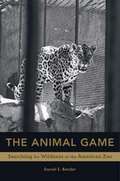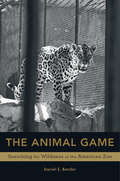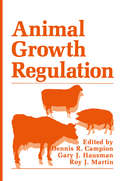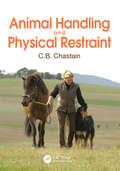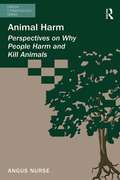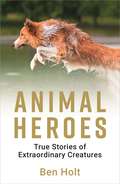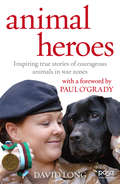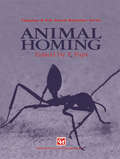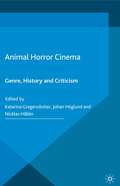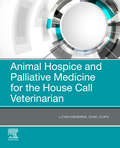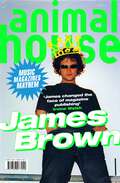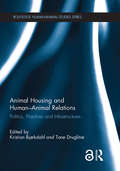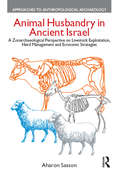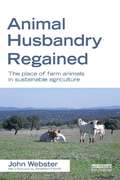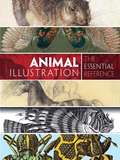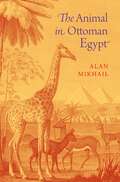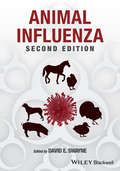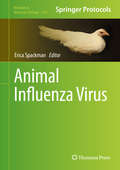- Table View
- List View
The Animal Game: Searching For Wildness At The American Zoo
by Daniel E. BenderTracing the global trade and trafficking in animals that supplied U.S. zoos, Daniel Bender shows how Americans learned to view faraway places through the lens of exotic creatures on display. He recounts the public’s conflicted relationship with zoos, decried as prisons by activists even as they remain popular centers of education and preservation.
The Animal Game: Searching For Wildness At The American Zoo
by Daniel E. BenderTracing the global trade and trafficking in animals that supplied U.S. zoos, Daniel Bender shows how Americans learned to view faraway places through the lens of exotic creatures on display. He recounts the public’s conflicted relationship with zoos, decried as prisons by activists even as they remain popular centers of education and preservation.
Animal Growth Regulation
by D. R. Campion G. J. Hausman R. J. MartinThe biotechnological advances of recent years have put us on the brink of unprecedented gains in animal productivity. Manipulation of animal growth rate and composition of gain is now possible by a variety of techniques. Ex amples include ingestion of beta-adrenergic agonists, injection of somatotropin, castration, immunization, and gene insertion. Animal Growth Regulation ad dresses modem concepts of growth regulation with an emphasis on agricul turally important animals. This emphasis is not exclusive, as many situations exist in which the only information available was generated in other species, and this information has been included for the sake of clarity and completeness. However, because of the overall orientation of this volume, particular attention has been given to the regulation of skeletal muscle, adipose tissue, and bone growth. Certain hormones and growth factors have a profound influence on growth regulation and this basic physiological knowledge is being harnessed to maniplilate growth. Thus, considerable emphasis has been given to growth hor mone-somatomedinlinsulinlike growth factor regulation of cell and tissue growth. The involvement of peptides coded by protooncogenes and of negative growth regulators, such as transforming growth factor-l3, represents an emerging area of molecular biology wherein basic knowledge offers potential exploitation for growth manipulation. Opportunities also exist for regulation of protein turn over, especially from the standpoint of protein degradation. Therefore, a place was reserved for these topics in order to provide relevant basic knowledge.
Animal Handling and Physical Restraint
by C. B. ChastainKey features: Stresses safety in handling, restraint, and containment of animals Covers handling and restraint of all domestic and common tamed animals and provides information on normal animal behavior and welfare Discusses how to recognize signs in animals of poor handling and containment Reviews zoonotic disease risks to animal handlers, particularly from normal-appearing animals, and how to avoid transmission of disease Features over 200 informative line drawings for clarity and simplicity of illustration Explains how to tie useful knots and hitches and when to use them for restraint Includes basic ethical considerations and legal liabilities of animal handling and containment Presents steps to prevent animal escapes, barn fires, and problems with transport Authored by an experienced veterinary educator in clinical medicine for veterinarians, veterinary students, pre-veterinary students, veterinary technicians and technologists, animal scientists, and animal owners Proper handling and restraint are essential to the welfare of captive animals, allowing them to be examined, groomed and treated in ways that contribute to their optimum quantity and quality of life. The aim of the book is to prepare future or current veterinarians and veterinary technologists, technicians/nurses, and assistants to be able to handle animals more safely and gain the confidence of animals and their owners. In turn, they will be able to instruct owners in proper animal handling methods, reducing the risk of physical injury or mutual infectious diseases. Throughout the book, the author emphasises that each animal is an individual and each handling environment provides its own advantages and disadvantages: handling an animal safely, humanely and efficiently requires practical knowledge of the species’ normal behaviour. This is explored in detail in each of the species-based chapters, which cover proper handling of domestic household and laboratory animals, as well as farm and ranch animals where safe handling aids the producer in both humane practice and greater profitability. After reading this book, the practitioner or student will be versed in the most basic part of the art of veterinary medicine: the safe handling of animals.
Animal Handling and Physical Restraint
by C. B. ChastainKey features: Stresses safety in handling, restraint, and containment of animals Covers handling and restraint of all domestic and common tamed animals and provides information on normal animal behavior and welfare Discusses how to recognize signs in animals of poor handling and containment Reviews zoonotic disease risks to animal handlers, particularly from normal-appearing animals, and how to avoid transmission of disease Features over 200 informative line drawings for clarity and simplicity of illustration Explains how to tie useful knots and hitches and when to use them for restraint Includes basic ethical considerations and legal liabilities of animal handling and containment Presents steps to prevent animal escapes, barn fires, and problems with transport Authored by an experienced veterinary educator in clinical medicine for veterinarians, veterinary students, pre-veterinary students, veterinary technicians and technologists, animal scientists, and animal owners Proper handling and restraint are essential to the welfare of captive animals, allowing them to be examined, groomed and treated in ways that contribute to their optimum quantity and quality of life. The aim of the book is to prepare future or current veterinarians and veterinary technologists, technicians/nurses, and assistants to be able to handle animals more safely and gain the confidence of animals and their owners. In turn, they will be able to instruct owners in proper animal handling methods, reducing the risk of physical injury or mutual infectious diseases. Throughout the book, the author emphasises that each animal is an individual and each handling environment provides its own advantages and disadvantages: handling an animal safely, humanely and efficiently requires practical knowledge of the species’ normal behaviour. This is explored in detail in each of the species-based chapters, which cover proper handling of domestic household and laboratory animals, as well as farm and ranch animals where safe handling aids the producer in both humane practice and greater profitability. After reading this book, the practitioner or student will be versed in the most basic part of the art of veterinary medicine: the safe handling of animals.
Animal Harm: Perspectives on Why People Harm and Kill Animals
by Angus NurseWhy do people harm, injure, torture and kill animals? This book evaluates the reasons why these crimes are committed and outlines the characteristics of the animal offender. It considers ethical and value judgements made about animals and the tacit acknowledgement and justification of unacceptable criminal behaviour towards the harming of animals made by offenders. Situating animal abuse, wildlife crime, illegal wildlife trading and other unlawful activities directed at animals firmly within Green Criminology, the book contends that this is a distinct, multi-dimensional type of criminality which persists despite the introduction of relevant legislation. Taking a broad approach, the book considers the killing and harming of animals in an international context and examines the effectiveness of current legislation, policy and sentencing. Including a section on further reading and useful organizations, this book is a valuable exploration into perspectives on the responsibility owed by man to animals as part of broader ecological and legal concerns. It will interest criminologists, ecologists, animal protectionists and those interested in law and society and law and the environment.
Animal Harm: Perspectives on Why People Harm and Kill Animals
by Angus NurseWhy do people harm, injure, torture and kill animals? This book evaluates the reasons why these crimes are committed and outlines the characteristics of the animal offender. It considers ethical and value judgements made about animals and the tacit acknowledgement and justification of unacceptable criminal behaviour towards the harming of animals made by offenders. Situating animal abuse, wildlife crime, illegal wildlife trading and other unlawful activities directed at animals firmly within Green Criminology, the book contends that this is a distinct, multi-dimensional type of criminality which persists despite the introduction of relevant legislation. Taking a broad approach, the book considers the killing and harming of animals in an international context and examines the effectiveness of current legislation, policy and sentencing. Including a section on further reading and useful organizations, this book is a valuable exploration into perspectives on the responsibility owed by man to animals as part of broader ecological and legal concerns. It will interest criminologists, ecologists, animal protectionists and those interested in law and society and law and the environment.
Animal Heroes: True Stories of Extraordinary Creatures
by Ben HoltAnimal Heroes contains some of the most extraordinary true tales of bravery across the natural world, from domestic pets to wild animals, proving that when it comes to facing danger there’s more to them than meets the eye.
Animal Heroes: Inspiring true stories of courageous animals
by David LongThe PDSA Dickin Medal (regarded as the animals’ Victoria Cross) has been awarded to just 64 animals, from the Blitz to present day, for their courage in times of crisis. Among these incredible true-life stories you will meet…G.I. Joe the plucky pigeon, who rescued over 100 lives by flying twenty miles in twenty minutes to deliver a message in World War II.Theo the steadfast springer spaniel, who served as a bomb-detection dog in Afghanistan.Rip the trusty mongrel, who saved many victims of the Blitz air-raids.Olga the courageous police horse, who bolted from the path of a flying bomb in World War II only to return to the scene and remain on duty.These heart-warming tales of gallantry and devotion will stay with you long after you turn the pages.Previously published as The Animals' VC.
Animal Homing (Chapman & Hall Animal Behaviour Series)
by F. PapiHoming phenomena must be considered an important aspect of animal behaviour on account of their frequent occurrence, their survival value, and the variety of the mechanisms involved. Many species regularly rely on their ability to home or reach other familiar sites, but how they manage to do this is often uncertain. In many cases the goal is attained in the absence of any sensory contact, by mechanisms of indirect orientation whose complexity and sophistication have for a long time challenged the skill and patience of many researchers. A series of problems of increasing difficulty have to be overcome; researchers have to discover the nature of orienting cues, the sensory windows involved, the role of inherited and acquired information, and, eventually, how the central mechanisms process information and control motory responses. Naturally, this book emphasizes targets achieved rather than areas unexplored and mysteries unsolved. Even so, the reader will quickly realize that our knowledge of phenomena and mechanisms has progressed to different degrees in different animal groups, ranging from the mere description of homing behaviour to a satisfactory insight into some underlying mechanisms. In the last few dacades there have been promising developments in the study of animal homing, since new approaches have been tried out, and new species and groups have been investigated. Despite this, homing phenomena have not recently been the object of exhaustive reviews and there is a tendency for them to be neglected in general treatises on animal behaviour.
Animal Horror Cinema: Genre, History and Criticism
by Johan Höglund Katarina Gregersdotter Nicklas HållénThis first full-length scholarly study about animal horror cinema defines the popular subgenre and describes its origin and history in the West. The chapters explore a variety of animal horror films from a number of different perspectives. This is an indispensable study for students and scholars of cinema, horror and animal studies.
Animal Hospice and Palliative Medicine for the House Call Vet - E-Book
by Lynn HendrixGain the understanding you need to provide compassionate, end-of-life pet care. Animal Hospice and Palliative Medicine for the House Call Veterinarian provides an all-in-one guide to the skills and challenges related to this growing area of veterinary care. From setting up your business and performing your first in-home consultation to managing pain, performing in-home euthanasia, and providing grief support to the family, this book walks you through each step of care. Written by Dr. Lynn Hendrix, a leading expert and researcher in veterinary palliative medicine, this practical resource shows how to improve the quality of care for pets in the final stages of life. Comprehensive coverage addresses the essential topics of palliative care, hospice, and euthanasia. Key topics range from setting up a mobile business, in-home consultations to pain management, complementary medicine, physical support for the pet, and much more. Information on the diseases commonly seen at the end of life includes disease progression and trajectories. Single-source review covers animal end-of-life care and consulting, specifically through mobile veterinary services. 100 full-color clinical photos depict the concepts and procedures of animal palliative care. Practical insights are provided in the areas of family grief support, compassion fatigue, managing difficult home visits, and dispelling the myths of animal hospice and euthanasia. Author Lynn Hendrix is an expert veterinarian with than a decade of experience in the field of Veterinary Palliative Medicine and is also the owner/founder of Beloved Pet Mobile Vet, a company providing in-home animal hospice and euthanasia.
Animal House
by James BrownMusic, Magazines & MayhemBetween 1994 and 1997, James Brown's loaded magazine became the the must-buy and must-be-in publication of the decade. It won every award going, year after year, and came to define not only its audience but also a generation. Bright, loud, funny, provocative, ambitious and careless, loaded was read from the barracks of Afghanistan to the England dressing room at Euro '96. It captured a hedonistic lifestyle of alcohol, cocaine and more. The last great hurrah before the end of the century. It was the biggest noise in the golden generation of magazine publishing, rocketing from zero to half a million sales in a matter of months. What MTV had been to the 80s, loaded was to the 90s.ANIMAL HOUSE follows James Brown's remarkable career from a high school drop-out fanzine writer with few qualifications to NME features editor aged 22, and loaded founder at 27. In between, his mother died in tragic circumstances and gradually his own drug and alcohol use began to take over. Loaded's unexpected success legitimised (and paid for) James's lifestyle, and it wasn't until he crashed and burned at GQ, and went through rehab, that any sense of perspective kicked in.Recuperating on the island of Mustique whilst plotting his return with Oz founder Felix Denis, James was asked by neighbour Lord Patrick Lichfield: "How on earth did you manage to sell so many magazines whilst taking so many drugs?"This book is his answer.
Animal Housing and Human-Animal Relations: Politics, Practices and Infrastructures (Routledge Human-Animal Studies Series)
by Kristian Bjørkdahl Tone DruglitrøThis book provides an in-depth investigation into the practices of animal housing systems with international contributions from across the humanities and social sciences. By attending to a range of different sites such as the zoo, the laboratory, the farm and the animal shelter, to name a few, the book explores material technologies from the perspective that these are integrated parts of a larger biopolitical infrastructure and questions how animal housing systems, and the physical infrastructures that surround central human-animal practices, come into being. Chapter 11 of this book is freely available as a downloadable Open Access PDF under a Creative Commons Attribution-Non Commercial-No Derivatives 3.0 license. https://s3-us-west-2.amazonaws.com/tandfbis/rt-files/docs/Open+Access+Chapters/9781138854116_oaChapter11.pdf
Animal Housing and Human-Animal Relations: Politics, Practices and Infrastructures (Routledge Human-Animal Studies Series)
by Kristian Bjørkdahl Tone DruglitrøThis book provides an in-depth investigation into the practices of animal housing systems with international contributions from across the humanities and social sciences. By attending to a range of different sites such as the zoo, the laboratory, the farm and the animal shelter, to name a few, the book explores material technologies from the perspective that these are integrated parts of a larger biopolitical infrastructure and questions how animal housing systems, and the physical infrastructures that surround central human-animal practices, come into being. Chapter 11 of this book is freely available as a downloadable Open Access PDF under a Creative Commons Attribution-Non Commercial-No Derivatives 3.0 license. https://s3-us-west-2.amazonaws.com/tandfbis/rt-files/docs/Open+Access+Chapters/9781138854116_oaChapter11.pdf
Animal Husbandry in Ancient Israel: A Zooarchaeological Perspective on Livestock Exploitation, Herd Management and Economic Strategies
by Aharon SassonAnimals have been used to human advantage for thousands of years. 'Animal Husbandry in Ancient Israel' presents an analysis of caprines and cattle husbandry in the Southern Levantine Bronze and Iron Age. The book employs key methodological approaches - comparative analysis, taphonomy, Geographic Information System spatial analysis, and ethnographic studies - to challenge prevalent views on the Southern Levantine ancient economy. 'Animal Husbandry in Ancient Israel' argues that the key concern of nomadic, rural and urban populations was survival - the common household maintained a self-sufficient economy - rather than profit, specialization or trade. The book will be of value to all those interested in the dynamic relationship between humans and animals in ancient Israel.
Animal Husbandry in Ancient Israel: A Zooarchaeological Perspective on Livestock Exploitation, Herd Management and Economic Strategies
by Aharon SassonAnimals have been used to human advantage for thousands of years. 'Animal Husbandry in Ancient Israel' presents an analysis of caprines and cattle husbandry in the Southern Levantine Bronze and Iron Age. The book employs key methodological approaches - comparative analysis, taphonomy, Geographic Information System spatial analysis, and ethnographic studies - to challenge prevalent views on the Southern Levantine ancient economy. 'Animal Husbandry in Ancient Israel' argues that the key concern of nomadic, rural and urban populations was survival - the common household maintained a self-sufficient economy - rather than profit, specialization or trade. The book will be of value to all those interested in the dynamic relationship between humans and animals in ancient Israel.
Animal Husbandry Regained: The Place of Farm Animals in Sustainable Agriculture
by John WebsterThe farming of animals for meat and milk confronts a stark dilemma. While world demand from a growing and more affluent human population is increasing rapidly, there are strong counter-arguments that we should eat less meat and pay more attention to environmental protection, animal welfare and human health and well-being. The aim of this book is to identify and explain the causes and contributors to current problems in animal husbandry, especially those related to 'factory farming', and advance arguments that may contribute to its successful re-orientation. Husbandry is considered in its broadest sense, namely the productive and sustainable use of the land for the good of all (plants, humans and other animals). The first part of the book outlines principles and arguments necessary to engage with current problems: depletion of natural resources and destruction of environment, animal welfare, food and health, fair trade and sharing resources. These arguments are illustrated by examples and sufficient evidence to justify the argument without obscuring the message. The second part presents a series of constructive proposals for change and development in animal husbandry, both in the developed world and subsistence agriculture. These include more integrated crop and livestock farming systems, the ethics of animal welfare and environmental management, and the evolution of a new social contract whereby the rights of the people to a fair share of good, safe food and a green and pleasant land are matched by a shared responsibility to preserve these things.
Animal Husbandry Regained: The Place of Farm Animals in Sustainable Agriculture
by John WebsterThe farming of animals for meat and milk confronts a stark dilemma. While world demand from a growing and more affluent human population is increasing rapidly, there are strong counter-arguments that we should eat less meat and pay more attention to environmental protection, animal welfare and human health and well-being. The aim of this book is to identify and explain the causes and contributors to current problems in animal husbandry, especially those related to 'factory farming', and advance arguments that may contribute to its successful re-orientation. Husbandry is considered in its broadest sense, namely the productive and sustainable use of the land for the good of all (plants, humans and other animals). The first part of the book outlines principles and arguments necessary to engage with current problems: depletion of natural resources and destruction of environment, animal welfare, food and health, fair trade and sharing resources. These arguments are illustrated by examples and sufficient evidence to justify the argument without obscuring the message. The second part presents a series of constructive proposals for change and development in animal husbandry, both in the developed world and subsistence agriculture. These include more integrated crop and livestock farming systems, the ethics of animal welfare and environmental management, and the evolution of a new social contract whereby the rights of the people to a fair share of good, safe food and a green and pleasant land are matched by a shared responsibility to preserve these things.
Animal Illustration: The Essential Reference
by Carol Belanger GraftonComprehensive and entertaining, this volume comprises the greatest works in animal illustration from the Middle Ages through the twentieth century. The chronological presentation of hundreds of black-and-white and color images begins with a medieval illuminated manuscript by the Limbourg brothers and the Renaissance works of Albrecht Dürer and other artists from the first centuries of printing. Subsequent illustrations include the seventeenth-century real and imaginary animals of Matthäus Merian and the unique eighteenth-century compilations of Albertus Seba. Nineteenth-century images are drawn from sources as diverse as J. G. Heck's Bilder Atlas; the prints of Georges Baron Cuvier; William Jardine's 40-volume Naturalist's Library; bird illustrations by John James Audubon, Alexander Wilson, Edward Lear, and many others; extraordinary butterfly and insect images by E. A. Seguy, as well as animal illustrations from Victorian chromolithograph die cuts. The exquisite Edwardian bestiary of the Detmold brothers brings the collection into the twentieth century, and ends with the imagery of contemporary dinosaur artist James Gurney.Detailed bibliographical information concerning every source—including biographical details of each artist—makes this collection a vital reference tool as well as a splendid resource of outstanding animal illustrations. Students of graphic art and illustration, as well as graphic designers and advertising professionals, will prize this treasury of material from many rare historic sources.
The Animal in Ottoman Egypt
by Alan MikhailSince humans first emerged as a distinct species, they have eaten, fought, prayed, and moved with other animals. In this stunningly original and conceptually rich book, historian Alan Mikhail puts the history of human-animal relations at the center of transformations in the Ottoman Empire from the sixteenth to the nineteenth centuries. Mikhail uses the history of the empire's most important province, Egypt, to explain how human interactions with livestock, dogs, and charismatic megafauna changed more in a few centuries than they had for millennia. The human world became one in which animals' social and economic functions were diminished. Without animals, humans had to remake the societies they had built around intimate and cooperative interactions between species. The political and even evolutionary consequences of this separation of people and animals were wrenching and often violent. This book's interspecies histories underscore continuities between the early modern period and the nineteenth century and help to reconcile Ottoman and Arab histories. Further, the book highlights the importance of integrating Ottoman history with issues in animal studies, economic history, early modern history, and environmental history. Carefully crafted and compellingly argued, The Animal in Ottoman Egypt tells the story of the high price humans and animals paid as they entered the modern world.
The Animal in Ottoman Egypt
by Alan MikhailSince humans first emerged as a distinct species, they have eaten, fought, prayed, and moved with other animals. In this stunningly original and conceptually rich book, historian Alan Mikhail puts the history of human-animal relations at the center of transformations in the Ottoman Empire from the sixteenth to the nineteenth centuries. Mikhail uses the history of the empire's most important province, Egypt, to explain how human interactions with livestock, dogs, and charismatic megafauna changed more in a few centuries than they had for millennia. The human world became one in which animals' social and economic functions were diminished. Without animals, humans had to remake the societies they had built around intimate and cooperative interactions between species. The political and even evolutionary consequences of this separation of people and animals were wrenching and often violent. This book's interspecies histories underscore continuities between the early modern period and the nineteenth century and help to reconcile Ottoman and Arab histories. Further, the book highlights the importance of integrating Ottoman history with issues in animal studies, economic history, early modern history, and environmental history. Carefully crafted and compellingly argued, The Animal in Ottoman Egypt tells the story of the high price humans and animals paid as they entered the modern world.
Animal Influenza
by David E. SwayneAnimal Influenza, Second Edition is a comprehensive text on animal influenza. Organized by species, coverage includes avian, swine, equine and mammals, with each section including data on influenza viruses, the infection and disease they cause, and strategies used in control. Covers the full range of topics within avian, swine, equine and mammalian influenzas in one comprehensive and authoritative text Provides a summarization of peer-reviewed and empirical data on influenza viruses, the infection, and diseases they cause Discusses strategies used in control of the disease Leading experts are drawn together to provide an international and multi-disciplinary perspective Fuses latest developments in basic scientific research with practical guidance on management of the disease
Animal Influenza
by David E. SwayneAnimal Influenza, Second Edition is a comprehensive text on animal influenza. Organized by species, coverage includes avian, swine, equine and mammals, with each section including data on influenza viruses, the infection and disease they cause, and strategies used in control. Covers the full range of topics within avian, swine, equine and mammalian influenzas in one comprehensive and authoritative text Provides a summarization of peer-reviewed and empirical data on influenza viruses, the infection, and diseases they cause Discusses strategies used in control of the disease Leading experts are drawn together to provide an international and multi-disciplinary perspective Fuses latest developments in basic scientific research with practical guidance on management of the disease
Animal Influenza Virus: Methods And Protocols (Methods in Molecular Biology #1161)
by Erica SpackmanAvian Influenza Virus, Second Edition aims to provide the essential methods used in working with animal influenza viruses, and to compile more advanced information that will guide the user in designing influenza studies. Influenza A viruses are among the most important pathogens for humans, food animals and companion animals. Research and diagnostics with animal influenza viruses are critical to animal health and it should be recognized that the needs and goals of animal agriculture and veterinary medicine are not always the same as those of public health. This volume sorts out the differences in the structure of the poultry, swine and equine industries, the biological differences of influenza virus from each animal group, and provides host, strain and lineage specific guidance and procedures. Written in the successful Methods in Molecular Biology series format, chapters include introductions to their respective topics, lists of the necessary materials and reagents, step-by-step, readily reproducible protocols, and notes on troubleshooting and avoiding known pitfalls.Authoritative and accessible, Avian Influenza Virus, Second Edition seeks to serve both professionals and novices with its well-honed methodologies in an effort to further our knowledge of these important pathogens.
